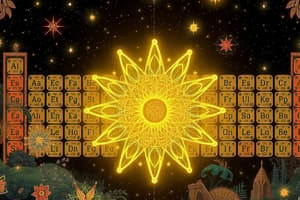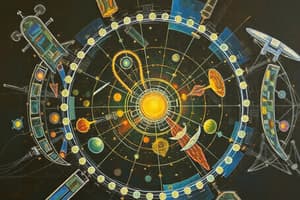Podcast
Questions and Answers
Which of the following statements about non-metals is true?
Which of the following statements about non-metals is true?
- Non-metals are found exclusively on the left of the staircase in the periodic table.
- Non-metals are always solid at room temperature.
- Non-metals can be found as solids, liquids, or gases at room temperature. (correct)
- Non-metals are good conductors of electricity.
What characteristic is shared by alkali metals?
What characteristic is shared by alkali metals?
- They are found in group 17 of the periodic table.
- They are non-metal elements.
- They have 2 valence electrons.
- They are very reactive with a single valence electron. (correct)
Which group of elements is known for being inert?
Which group of elements is known for being inert?
- Alkali metals
- Noble gases (correct)
- Alkaline earth metals
- Halogens
How is the number of neutrons in an atom calculated?
How is the number of neutrons in an atom calculated?
Which of the following statements correctly describes metalloids?
Which of the following statements correctly describes metalloids?
Flashcards
Chemical Property
Chemical Property
A property of a substance that describes how it behaves in a chemical reaction, often related to its ability to change into a new substance.
Physical Property
Physical Property
A property of a substance that can be observed or measured without changing the substance's chemical composition.
Atomic Number
Atomic Number
The number of protons in an atom's nucleus, which also determines the number of electrons.
Metals
Metals
Signup and view all the flashcards
Nonmetals
Nonmetals
Signup and view all the flashcards
Study Notes
Chemical and Physical Properties
- A chemical property describes how a substance reacts with another substance or its flammability.
- A physical property describes any characteristic other than a reaction.
Atomic Structure
- Atomic number equals the number of protons and electrons in an atom.
- Number of neutrons = mass number - atomic number.
Element Classification
- Nonmetals: Elements to the right of the periodic table's staircase, and hydrogen.
- Metals: Elements to the left of the staircase.
- Metalloids: Elements that touch the staircase.
Properties of Element Categories
- Metals: Solid at room temperature, shiny, malleable, good conductors of heat and electricity.
- Nonmetals: Solid, liquid, or gas at room temperature, dull, non-malleable, poor conductors.
- Metalloids: Solid at room temperature, some shiny, some dull, non-malleable, and are insulators.
Groups in the Periodic Table
- Alkali Metals (Group 1, except Hydrogen): One valence electron, very reactive.
- Alkaline Earth Metals (Group 2): Two valence electrons, reactive.
- Halogens (Group 17): Seven valence electrons, very reactive.
- Noble Gases (Group 18): Eight valence electrons (except helium, which has two), inert.
Electron Configuration and Trends
- Elements in groups 1-13 tend to lose electrons to achieve stability. These are generally metals.
- Elements in groups 14-17 tend to gain electrons to achieve stability. These are generally nonmetals.
Studying That Suits You
Use AI to generate personalized quizzes and flashcards to suit your learning preferences.




